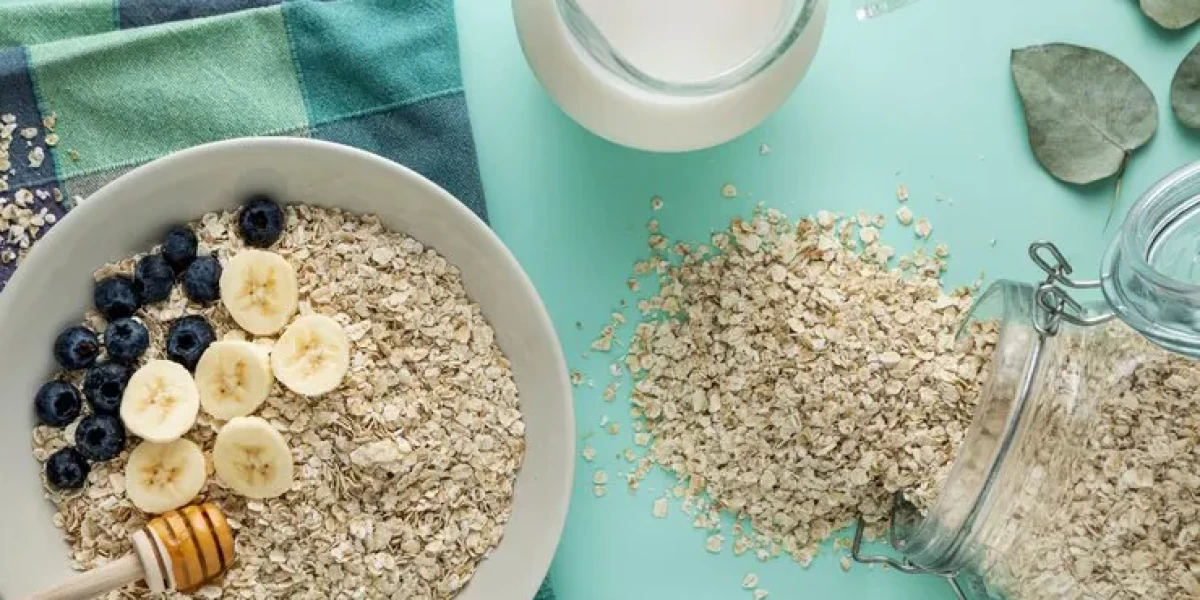Introduction
For individuals managing diabetes, oatmeal is increasingly popular due to its nutritional profile and potential to support blood sugar regulation. This humble, whole-grain food is an excellent source of slow-release carbohydrates and high in soluble fiber, specifically beta-glucan, which promotes steady energy levels. Oatmeal's versatility, easy preparation, and natural nutrient density make it appealing, but its particular benefits for those with diabetes set it apart. Adding oatmeal to a balanced diet can be a great way to start the day with a filling, nutrient-dense food that aligns well with blood sugar goals. Oatmeal Guide
Why Oatmeal?
Oatmeal has garnered popularity among people with diabetes as a nutritious, adaptable breakfast option that fits well within blood sugar management strategies. Oats are complex carbohydrates, meaning they break down more slowly in the body, helping avoid the rapid glucose spikes associated with simple carbs. Their high fiber content, specifically beta-glucan, plays a crucial role in stabilizing blood sugar by slowing digestion and moderating glucose absorption into the bloodstream. Additionally, oatmeal has a low glycemic index, indicating it produces a more gradual increase in blood sugar. This property is especially beneficial for those with diabetes, as it supports better control over post-meal glucose levels. When combined with other diabetes-friendly toppings like nuts, seeds, and berries, oatmeal can further enhance fiber and nutrient intake, making it a balanced and satisfying meal choice.
The Popularity of Oatmeal as a Nutritious Choice for People with Diabetes
Oatmeal's rise in popularity as a go-to breakfast choice for people with diabetes is rooted in its proven benefits and versatility. Beyond being easy to prepare, oatmeal is highly customizable, allowing individuals to tailor it to their tastes and dietary needs. For example, adding healthy fats from nuts or seeds can help slow the release of sugars even further, providing more sustained energy and better blood sugar stability. Moreover, oats contain essential vitamins, including B vitamins, iron, and magnesium, that support overall health and can complement a diabetes-friendly diet. In addition to its nutrient profile, oatmeal is cost-effective and widely available, making it a practical option. This popularity is also supported by research suggesting that the fiber in oats can improve insulin sensitivity and even aid in weight management, both crucial for people with diabetes. Oatmeal Guide
Overview of How Oatmeal Can Impact Blood Sugar Levels
Oatmeal can impact blood sugar levels positively, primarily due to its high fiber content and low glycemic index. Dietary fiber, notably beta-glucan, forms a gel-like substance in the digestive tract, reducing the rate of glucose absorption. This slower absorption reduces the likelihood of blood sugar spikes after meals, making it ideal for people managing diabetes. Beta-glucan has been associated with improved insulin responses, potentially aiding those with insulin resistance—a common issue in Type 2 diabetes. Choosing steel-cut or rolled oats over instant oats further enhances these benefits, as they are less processed and have a lower glycemic impact. This effect on blood sugar can contribute to greater daily energy consistency and fewer cravings, which can be especially beneficial for people with diabetes working toward stable glucose levels.
Understanding Diabetes and Diet Management
Diabetes management requires a comprehensive approach, with diet playing a crucial role. There are three main types of diabetes: Type 1, Type 2, and gestational diabetes. Type 1 diabetes is an autoimmune condition where the body attacks insulin-producing cells, requiring lifelong insulin therapy. Type 2 diabetes, the most common type, is often linked to insulin resistance and lifestyle factors and can sometimes be managed with dietary changes and lifestyle adjustments. Gestational diabetes occurs during pregnancy and usually resolves post-delivery, although it increases the risk of developing Type 2 diabetes later. Diet management is vital in all three types, as food choices directly impact blood glucose levels. A balanced diet with controlled portions of carbohydrates, sufficient fiber, lean proteins, and healthy fats is essential to managing diabetes effectively. Oatmeal Guide
The Role of Diet in Managing Diabetes Effectively
Diet is a cornerstone of diabetes management, as food directly influences blood sugar levels and can impact insulin sensitivity. In addition to providing energy, a well-planned diet for diabetes should help avoid large blood sugar fluctuations. High-fiber foods like oatmeal, non-starchy vegetables, whole grains, and legumes are especially beneficial as they help moderate blood glucose. For those with Type 2 diabetes, maintaining a balanced diet can improve insulin sensitivity, potentially reducing the need for medication. In Type 1 diabetes, carb counting and balanced meals are essential to align food intake with insulin doses. For gestational diabetes, diet adjustments can help maintain normal blood sugar levels without medication. By focusing on low-glycemic, nutrient-dense foods, people with diabetes can enjoy improved energy levels, better blood sugar control, and reduced risk of complications over time. Oatmeal Guide
Best 6 Health Benefits of Oatmeal for Diabetes

Oatmeal is a nutritious, diabetes-friendly food that supports blood sugar control while providing essential nutrients. This whole-grain breakfast option offers various health benefits for people managing diabetes, from stabilizing blood glucose to improving heart health. Here are the top six health benefits of oatmeal for individuals with diabetes.
1. Low Glycemic Index (GI) Score
The glycemic index (GI) measures how quickly a food raises blood sugar levels, which is crucial for people with diabetes. Low-GI foods, such as oatmeal, digest more slowly, leading to a gradual release of glucose into the bloodstream. With a GI score between 55 and 70, oatmeal’s lower ranking on this scale means it is less likely to cause rapid blood sugar spikes, making it an ideal choice for managing diabetes. By consuming low-GI foods like oatmeal, people with diabetes can better maintain stable glucose levels, which helps reduce the risk of complications. Steel-cut oats, a less processed type of oatmeal, have an even lower GI score, making them especially beneficial for blood sugar stability.
2. Fiber-Rich for Blood Sugar Control
Oatmeal is rich in two types of fiber: soluble and insoluble, each of which plays a unique role in diabetes management. Soluble fiber, specifically beta-glucan, forms a gel-like substance in the digestive tract, slowing carbohydrate digestion and glucose absorption. This slower digestion process helps avoid sudden spikes in blood sugar levels after meals, a common concern for people with diabetes. Insoluble fiber adds bulk to the diet, promoting healthy digestion and preventing constipation. High-fiber foods like oatmeal also support a feeling of fullness, making it easier for people with diabetes to manage weight and avoid overeating. Adding fiber-rich foods to the diet can be a key factor in controlling blood sugar and improving overall metabolic health. Oatmeal Guide
3. Potential to Lower Blood Sugar Levels
Research suggests that oatmeal can contribute to lower blood sugar levels over time, which is beneficial for managing diabetes. A study published in the Journal of Nutrition found that beta-glucan, the soluble fiber in oats, can improve glycemic control and reduce blood glucose levels. By slowing the absorption of carbohydrates, beta-glucan minimizes blood sugar fluctuations, leading to a more stable glucose profile throughout the day. Additionally, some studies indicate that regular consumption of oatmeal can enhance insulin sensitivity, meaning the body can more effectively use the insulin it produces. This impact on blood glucose can be particularly valuable for individuals with Type 2 diabetes who are working to improve their insulin response. Oatmeal Guide
4. Heart Health Benefits
Heart health is closely linked to diabetes management, as people with diabetes are at higher risk for heart disease. Oatmeal contains compounds that can support heart health, particularly beta-glucan, which has been shown to reduce LDL (bad) cholesterol levels. High cholesterol is a risk factor for cardiovascular disease, and oatmeal’s ability to lower cholesterol can be beneficial for overall cardiovascular health. Additionally, oatmeal’s antioxidant content helps reduce inflammation, another risk factor for heart disease. By incorporating oatmeal into a balanced diet, people with diabetes can potentially reduce the risk of cardiovascular complications and improve overall heart health, an important consideration given the interplay between diabetes and cardiovascular issues.
5. Promotes a Feeling of Fullness
Satiety, or the feeling of fullness, is essential for weight management, which is particularly important for individuals with diabetes. Oatmeal is high in fiber and protein, both of which contribute to prolonged satiety and can help prevent overeating and unhealthy snacking. A balanced blood sugar level is more attainable when portion control is practiced, as it reduces the chances of consuming excess calories. The fiber in oatmeal slows down digestion, providing longer-lasting energy and reducing cravings. With better appetite control, individuals with diabetes can find it easier to maintain a healthy weight, which can improve insulin sensitivity and reduce the risk of Type 2 diabetes complications.
6. Temporary Increase in Insulin Sensitivity
Some studies suggest that regular oatmeal consumption may temporarily increase insulin sensitivity, especially when it’s part of a well-balanced diet. Insulin sensitivity refers to how effectively the body’s cells respond to insulin, which is crucial for maintaining healthy blood sugar levels. Improved insulin sensitivity means that the body requires less insulin to manage blood glucose levels, a benefit particularly relevant for people with Type 2 diabetes who may have insulin resistance. By supporting better insulin function, oatmeal can contribute to more efficient blood sugar control and may help delay the need for medications or reduce the dosage over time. Oatmeal Guide
Nutritional Content of Oatmeal
Macronutrients and Micronutrients
Oatmeal provides a variety of essential nutrients, including carbohydrates, protein, and healthy fats, as well as vitamins and minerals. It’s an excellent source of magnesium, manganese, and iron, which are crucial for energy metabolism and cellular function. Magnesium, in particular, is important for individuals with diabetes, as it plays a role in insulin regulation and blood sugar control. Oatmeal is also a moderate source of protein, which, along with fiber, can help stabilize blood sugar by slowing digestion. This nutrient-rich profile makes oatmeal a balanced option that can support energy levels, satisfy hunger, and aid in managing diabetes effectively.
Types of Oatmeal and Their Nutritional Differences
Different types of oatmeal—such as steel-cut, rolled, and instant oats—offer varying nutritional benefits. Steel-cut oats are the least processed, retaining more fiber and having a lower glycemic index, making them ideal for blood sugar management. Rolled oats are more processed but still provide significant fiber and a moderate GI score, suitable for people with diabetes when paired with protein and healthy fats. Instant oats, while convenient, are more processed and have a higher GI score, which may cause quicker blood sugar spikes. For individuals with diabetes, steel-cut or rolled oats are generally the best choices to maximize nutritional benefits and maintain stable blood glucose levels. Oatmeal Guide
Dietary Tips for Incorporating Oatmeal in a Diabetic Diet
Oatmeal can be a nutritious addition to a diabetic diet when prepared mindfully. The right portion sizes, types of oats, and additions can enhance its benefits and prevent unwanted blood sugar spikes. Since oatmeal is a carbohydrate-based food, it’s essential to eat it in a way that minimizes its glycemic impact. From choosing steel-cut oats to adding nutrient-dense toppings, strategic preparation makes oatmeal a diabetes-friendly meal that’s both filling and balanced. This article provides practical tips on how to incorporate oatmeal into a diabetic diet for optimal blood sugar management.
Choosing the Right Type of Oats for Blood Sugar Management
When selecting oats for a diabetes-friendly diet, the type of oats makes a significant difference. Steel-cut oats are the least processed, have a lower glycemic index, and take longer to digest, meaning they cause slower blood sugar rises. Rolled oats are another good option, as they have a moderate glycemic index. Instant oats, on the other hand, are more processed and often have added sugars, causing a quicker spike in blood glucose. Whenever possible, choose steel-cut or rolled oats for a more stable blood sugar response. The preparation method also matters; avoid adding sugar or artificial sweeteners, and instead, flavor with spices or low-glycemic fruits for a healthier option. For people with diabetes, selecting whole oats over instant varieties is a crucial step for better blood sugar control. Oatmeal Guide
Ideal Portion Sizes for Diabetes
Portion control is essential when consuming oatmeal on a diabetic diet. A typical serving size of oatmeal for diabetes management is around 1/2 cup of cooked oats, which provides approximately 15 grams of carbohydrates. Sticking to this portion size helps manage blood sugar levels without consuming excess carbs. Larger portions can lead to blood sugar spikes, so it's essential to measure servings accurately. Pairing oatmeal with healthy fats or proteins—like nuts, seeds, or Greek yogurt—can also enhance its staying power, reducing the urge to snack soon after eating. Adhering to proper portion sizes ensures that oatmeal remains a balanced and safe choice for those monitoring their blood glucose levels.
Healthy Additions to Enhance Oatmeal’s Benefits
Oatmeal is highly customizable, and adding the right toppings can boost its nutritional value without causing blood sugar spikes. Berries, like blueberries and strawberries, are excellent low-glycemic fruits that provide antioxidants and fiber. Apples, cut into small pieces and mixed with cinnamon, add flavor and beneficial nutrients without significantly raising blood sugar. Healthy fats like nuts and seeds (such as almonds, walnuts, chia, or flaxseeds) provide added texture, increase satiety, and can slow glucose absorption. Cinnamon is another flavorful addition that may help improve insulin sensitivity, making it a great choice for people with diabetes. These ingredients not only enhance the taste but also add fiber, protein, and healthy fats that stabilize blood sugar and make oatmeal a more balanced meal. Oatmeal Guide
Oatmeal Recipes for Diabetics
Creating diabetes-friendly oatmeal recipes is easy and can add variety to a diabetic diet. A simple recipe is to combine steel-cut oats with a sprinkle of cinnamon, a handful of fresh berries, and a tablespoon of chopped nuts. Another option is to make savory oatmeal by adding vegetables like spinach and mushrooms along with a poached egg for extra protein. Meal prepping oatmeal in advance can make morning routines easier; cook a large batch of steel-cut oats and portion them into containers for the week. Avoid adding sugar or syrup, and instead, rely on natural flavors from spices or fruit. These recipes provide balanced options that support stable blood sugar levels while adding convenience to meal planning.
Risks and Considerations When Eating Oatmeal for Diabetes
While oatmeal has several benefits, there are some considerations for those managing diabetes. Portion control is critical, as overeating can lead to blood sugar spikes. Many packaged oatmeals, especially flavored instant varieties, contain added sugars and artificial flavors, which can quickly raise glucose levels. Always check ingredient labels and opt for plain oats over pre-flavored options to minimize these risks. Additionally, some people may have gluten sensitivities or celiac disease, as oats can sometimes be contaminated with gluten during processing. For those with gluten sensitivity, choosing certified gluten-free oats is important, while others may consider oat alternatives like quinoa flakes or chia pudding. Monitoring portion sizes, selecting the right type of oats, and avoiding added sugars can make oatmeal a safe and effective choice for diabetes management. Oatmeal Guide
Potential for Overeating and Blood Sugar Spikes
Overeating even healthy carbs like oatmeal can result in higher blood sugar levels. Sticking to a 1/2 cup serving of cooked oats and balancing it with protein or healthy fats can help mitigate this. It’s easy to overindulge in oatmeal, especially with tasty toppings, so being mindful of portion sizes is crucial. Flavored instant oatmeal is particularly problematic due to high sugar content and added preservatives. Choosing whole oats and adding natural flavors can help keep oatmeal a diabetes-friendly food that supports, rather than disrupts, blood glucose levels.
Allergies and Sensitivities
Some individuals with gluten sensitivity or celiac disease may need to avoid oats unless they are certified gluten-free, as cross-contamination is common in oat processing. Additionally, while oats are generally safe for most people, a small number of individuals may have oat-specific allergies. Those with oat sensitivities can explore alternative grains like quinoa, amaranth, or chia seeds for similar benefits. Being aware of these potential issues helps ensure oatmeal can be safely included in a diabetes-friendly diet without complications.
Healthy Eating Tips for Diabetes Beyond Oatmeal
Incorporating oatmeal into a diabetic diet can be beneficial, but a balanced approach to nutrition is essential for effective diabetes management. Beyond oatmeal, choosing nutrient-dense foods, managing carbohydrate intake, and balancing meals with protein and healthy fats can support stable blood sugar levels. By following a few key principles, such as avoiding processed sugars, timing meals wisely, and selecting the right additions, people with diabetes can create meals that are both satisfying and blood-sugar friendly.
- Balancing Carbohydrates and Protein
- Balancing carbohydrates with protein is crucial for stabilizing blood sugar levels, as protein slows the digestion of carbs and reduces spikes in glucose. When eating oatmeal, it’s beneficial to pair it with a protein source to improve satiety and provide more sustained energy. For example, eggs make a great companion to oatmeal, adding protein and healthy fats that help maintain blood sugar levels. Greek yogurt is another excellent addition, as it’s rich in protein and has a low glycemic impact, making it ideal for a diabetes-friendly meal. Nuts like almonds, walnuts, or chia seeds not only offer protein but also add fiber and healthy fats, enhancing the nutrient profile of oatmeal. By combining oatmeal with these protein sources, individuals can create a balanced meal that promotes steady blood sugar control and supports long-term diabetes management.
- Avoiding Processed Sugars and Additives
- Avoiding processed sugars and additives is essential for maintaining stable blood sugar levels, as added sugars can cause rapid glucose spikes. Many pre-packaged oatmeals, especially instant or flavored varieties, contain added sugars and artificial flavors. Reading labels carefully is crucial to avoid these hidden sugars, and opting for plain, whole oats is always the best choice. For those who prefer some sweetness, natural alternatives like cinnamon, nutmeg, or a dash of stevia can be used instead. Cinnamon, in particular, is known for its potential to improve insulin sensitivity, making it a beneficial addition for people with diabetes. Avoiding processed sugars in oatmeal and other foods can reduce cravings and support overall health, making it easier to adhere to a diabetes-friendly diet. Oatmeal Guide
- Timing Meals for Optimal Blood Sugar Control
- Timing meals appropriately can make a significant difference in blood sugar management, as eating at consistent intervals helps prevent drastic blood sugar swings. Consuming oatmeal in the morning can provide a slow-release energy source, reducing the likelihood of mid-morning cravings. Since oatmeal is high in fiber, it helps maintain satiety, which may prevent snacking on less healthy options later in the day. Additionally, eating balanced meals and snacks every 3–4 hours can support more stable blood glucose levels, reducing the risk of hypoglycemia or hyperglycemia. By structuring meals around a consistent schedule, including high-fiber options like oatmeal for breakfast, individuals with diabetes can enjoy steadier energy throughout the day and improved blood sugar management. Oatmeal Guide
Conclusion
Oatmeal can play a beneficial role in a diabetes-friendly diet, offering a nutrient-dense, fiber-rich option for breakfast or snacks. Paired with protein and healthy fats and complemented by a balanced approach to other meals, oatmeal helps promote stable blood sugar levels. By choosing whole oats, avoiding added sugars, and consuming oatmeal as part of a timed, balanced eating plan, people with diabetes can enjoy its benefits without compromising blood sugar control.
Frequently Asked Questions (FAQs)
Can oatmeal help lower my blood sugar levels?
Oatmeal has a low glycemic index and contains fiber, which can help slow the release of glucose and promote steady blood sugar levels. However, it does not directly lower blood sugar but can contribute to better management. Oatmeal Guide
Which type of oatmeal is best for people with diabetes?
Steel-cut oats and rolled oats are the best choices for people with diabetes because they have a lower glycemic index compared to instant oats, which are more processed and can cause quicker glucose spikes.
How often can I eat oatmeal if I have diabetes?
Oatmeal can be enjoyed daily as part of a balanced diet, provided it is portioned correctly and paired with protein or healthy fats to reduce its impact on blood sugar.
What should I avoid adding to oatmeal to keep it diabetes-friendly?
Avoid adding sugar, flavored syrups, or processed sweeteners to oatmeal. Instead, use natural flavors like cinnamon, nutmeg, or a few berries.
Are there any risks to eating oatmeal every day with diabetes?
Eating oatmeal every day is generally safe for diabetes, but monitoring portion sizes is essential to prevent excessive carbohydrate intake.
How does oatmeal compare to other breakfast options for diabetes?
Oatmeal is a fiber-rich, low-glycemic option that promotes stable blood sugar levels, making it a great alternative to high-sugar cereals or processed breakfasts. It provides lasting energy and pairs well with other blood-sugar-friendly foods.
*Image credits- freepik*
Important Notice:
The information provided on “health life ai” is intended for informational purposes only. While we have made efforts to ensure the accuracy and authenticity of the information presented, we cannot guarantee its absolute correctness or completeness. Before applying any of the strategies or tips, please consult a professional medical adviser.













